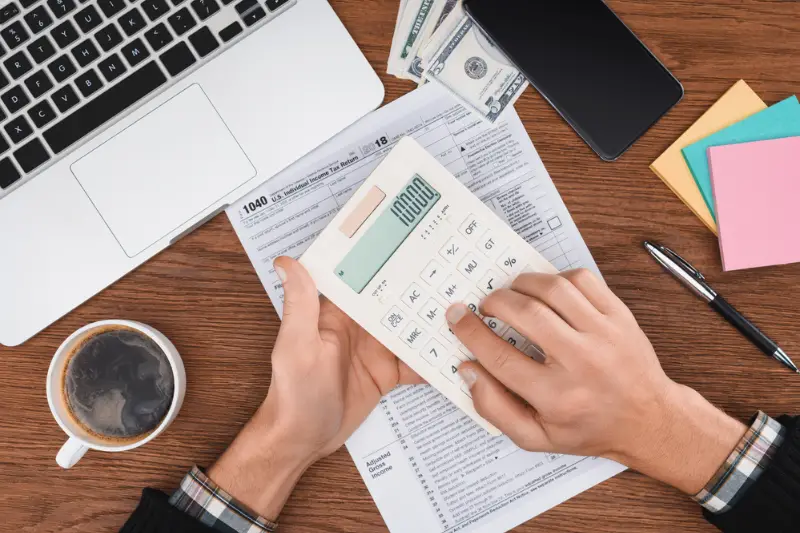Click here to get this post in PDF
Self-employment taxes are for individuals who work for themselves rather than as company employees and must pay. When someone is self-employed, they are considered both the employer and the employee, requiring them to cover both the employer and employee portions of certain taxes, such as Social Security and Medicare taxes, commonly referred to as self-employment taxes. To determine the amount owed, self-employed individuals can utilise tools like tax calculators (similarly to corporate tax calculators for businesses) to simplify the process.
Calculating self-employment taxes involves assessing the net earnings of the individual’s business, typically determined by deducting allowable business expenses from the business’s gross income. As self-employed individuals are responsible for paying both the employer and employee portions, the self-employment tax rate is typically higher than the combined rate for employees and employers.
Self-employed individuals must comprehend their tax obligations, maintain accurate records of business income and expenses, and make estimated tax payments throughout the year to evade penalties and ensure compliance with tax laws. Corporate tax calculators can assist in simplifying these calculations and aid self-employed individuals in accurately estimating their tax liabilities.
The different types of self-employment taxes
1. Self-employment tax
Self-employment tax is a fundamental tax obligation for self-employed individuals. Class 2 and Class 4 National Insurance contributions comprise two components. As of the current tax year, 2023/2024, the self-employment tax rate is set at 13.8% of net earnings. This includes Class 2 and Class 4 National Insurance contributions.
- Class 2 National Insurance contributions are paid on profits between £6,725 and £9,880. The rate is £3.15 per week.
- Class 4 National Insurance contributions are paid on profits above £9,880. The rate is 9% of profits between £9,880 and £50, 270 and 2% of profits above £50,270.
The total self-employment tax rate is, therefore, 13.8%. This is slightly lower than the previous tax year, 2022/2023, when the rate was 15.05%. The reduction in the self-employment rate was announced in the 2022 Spring Statement.
2. Value Added Tax (VAT)
If your annual turnover exceeds the VAT threshold, which is subject to change, you may be required to register for Value Added Tax (VAT). VAT is a consumption tax levied on goods and services. It is essential to understand the VAT registration process, rates, obligations, and the various VAT schemes available to self-employed individuals in the UK.
The current VAT threshold for the 2023/2024 tax year is £85,000. If your annual turnover is £85,000 or more, you must register for VAT. However, you can choose to register for VAT if your turnover is less than £85,000.
Several different VAT schemes are available to self-employed individuals in the UK. These schemes can reduce your VAT liability and simplify your VAT compliance. The most suitable scheme for you will depend on your business activities and turnover.
3. Medicare Tax
Like Social Security tax, self-employed individuals are responsible for the employer and employee elements of Medicare tax. Medicare tax contributes to funding the National Health Service (NHS), which provides healthcare to people aged 65 and older and certain individuals with disabilities. The current tax rate for Medicare is 2.9% on all net earnings, with no upper limit.
This means that if you are self-employed and have net earnings of £100,00, you will pay £2,900 in Medicare tax. The Medicare tax is a flat tax, meaning your pay rate does not change as your earnings increase.
4. Self-Assessment Tax Return
As a self-employed individual in the UK, you must complete a Self-Assesment tax return each year. This return reports your income, expenses, and tax liabilities to Her Majesty’s Revenue and Customs (HMRC). Maintaining accurate records of your business income and expenses throughout the year is crucial to report your self-assessment tax return accurately.
5. Payments on Account
Payments on Account are advance tax payments made towards your future tax liabilities. If your tax bill exceeds a certain threshold, you may be required to make payments on account. These payments are typically made in two instalments and help spread your tax liabilities across the year. It is essential to plan your finances accordingly to meet these payment obligations.
The threshold for payments on account is £1,000. This means that if your tax bill for the previous year was £1,000 or more, you would be required to make payments on account. The first payment on account is due on 31st January of the current year, and the second payment on account is due on 31st July of the current year.
6. Allowable expenses
As self-employed, you can deduct certain allowable expenses from your business income, reducing your overall tax liability. Understanding the HMRC guidelines for allowable expenses and keeping accurate records of your business expenses to claim them appropriately is vital.
Here are a few of the most common allowable expenses for self-employed individuals:
- Travel expenses
- Office expenses
- Computer and equipment expenses
- Marketing and advertising expenses
- Professional fees
- Training expenses
It is important to note that not all expenses are allowable. You can find a full list of allowable expenses on the HMRC website.
Conclusion
Becoming self-employed requires a solid understanding of the different types of self-employment taxes. By familiarising yourself with income tax, National Insurance Contributions (Class 2 and Class 4), Value Added Tax (VAT), Self-Assessment tax returns, Payments on Account, and allowable expenses, you can effectively manage your tax obligations, remain compliant with the law and optimise your finances. It is recommended to consult with a tax professional, use a corporation tax calculator or use HMRC resources to ensure accurate reporting and compliance with the ever-evolving tax regulations.
You may also like: 4 Strategies to Make Your Tax Preparation Easier
Image source: Depositphotos.com

